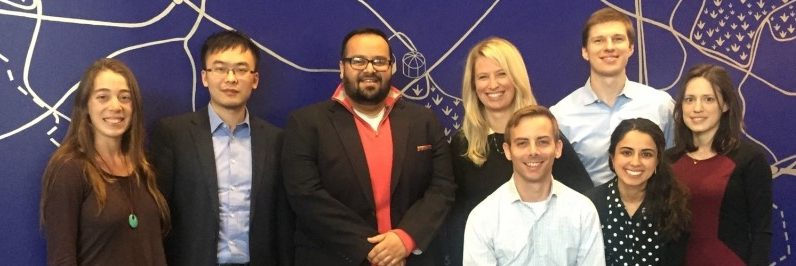The Net Impact Club at Dartmouth’s Tuck School of Business recently organized an Education Trek to tour a range of educational organizations in Boston, and this week’s Fridays from the Frontline provides a thoughtful reflection on that experience by one of its participants. Erica Toews, MBA ’18, (pictured above, far left) details the trek’s four stops, which included a Boston public school, a charter school, an education technology company and a nonprofit education organization. Toews’s pre-MBA career included working as a librarian at Stanford Law School, a legal assistant at Google, a teacher with the Fulbright Commission in Malaysia, and a product developer for elementary math-focused education technology firm Zearn.
Read on to learn some of the valuable insights Toews and others drew as part of the recent trek. As she shares, their day ended with an exhortation from the chief of staff at the nonprofit education organization they visited to seek out careers that will let them say, “I know why I’m at work every day.” Our thanks to Toews and to Tuck for allowing us to share her experience with the Clear Admit audience.
The following post has been republished in its entirety from its original source, the Tuck360: MBA Blog.
The Power of Education: Tuck Net Impact Education Trek
By Erica Toews T’18
The Net Impact Club led an inspiring education trek to Boston on Friday. To get multiple perspectives on education, we visited a public school, a charter school, an education technology company, and a nonprofit education organization. It was motivating to hear professionals speak with such passion for their work and to hear different approaches to education.
Avi Sethi T’16, strategic projects manager at Boston Public Schools (BPS), organized an amazing morning for us. Deputy Superintendent Dr. Karla Estrada had a presentation style that made it clear she has spent 20 years in education. She encouraged us to look at equity from an innovation lens and emphasized the importance of functioning as a team. She talked about the core values of BPS—equity, coherence, and innovation—and how all 126 schools in the district draw on these values to equip students with the four Cs: creative thinking, communication, critical thinking, and collaboration.
Next, we heard from the first panel of three speakers. Chief of Operations John Hanlon is working on two big initiatives to improve transportation and to extend learning time by adding 40 minutes to the school day. Chief Financial Officer Eleanor Laurence is breaking the framework of budgeting only one year in advance and leading the charge on long-term financial planning. Executive Director of Human Capital Zack Scott is shifting his focus from hiring to recruiting and developing. All three of them advised us to think about working in the public sector as opposed to the nonprofit sector and not to be afraid of doing unconventional things to get a foot in the door.
We heard from a second panel of three speakers. Program Manager for School Turnaround and Transformation Shira DeCovnick coordinates preventive and interventionist support for the lowest performing schools in the district. Assistant Superintendent for Social-Emotional Learning and Wellness Amalio Nieves is dedicated to ensuring a safe, healthy, and welcoming environment for students and teachers. Assistant Superintendent of Equity Becky Shuster spoke about proactive approaches to equity, with a special focus on racial and ethnic equity. They all challenged us to think about how to make public education more equitable.
Next, we visited an Uncommon School in Roxbury. Uncommon is a network of 49 public charter schools in New York, New Jersey, and Massachusetts. We walked through the silent hallways decorated with student work to observe a classroom in session. The teacher led a discussion on ancient Rome, and the students sat in their uniforms and raised their hands to participate. Each classroom is decorated with college posters to motivate student achievement. The level of student engagement and discipline is especially impressive given that Uncommon Schools are 100 percent lottery based. Our host attributed the success of Uncommon to the fact that leaders are trained internally, starting as teachers and growing within the organization. He discussed how the school is dedicated to infusing the student experience with both rigor and joy.
We traveled to Cengage, a company of 5,000 employees that provides content for one billion learners in the K-12, higher education, and professional markets worldwide. The second-largest publisher of course materials in the United States, Cengage is transitioning to digital content. Product Director Lauren Murphy spoke about the process of repositioning to enter the education technology space. One challenge of moving from 150 years of printing books to developing digital content has been training the salesforce on how to sell software. Lauren made an interesting point that technology provides an affordable solution that meets student needs, enabling the company to align its mission with a strategy for financial success.
The trek ended on a high note with our visit to Year Up, a one-year program for 18- to 24-year-olds with high school degrees. Year Up provides young adults with six months of learning and development, during which they receive technical and professional skills training, and six months of an internship. Students receive stipends, but money is taken out of their checks each time they break the contract. If students break the contract enough times, they “fire themselves” and are required to leave the program. Chief of Staff Bryan Mahony told us that 25 percent of Year Up students don’t finish the year, but he is not disheartened by this statistic because it signifies that Year Up is reaching its target audience: They want the riskiest students. Year Up is tackling the market mismatch between the skills of young people and the 12 million job openings, which Bryan called “the defining economic and social justice issue of our time.” Before we left, Bryan urged us to find jobs that enable us to say, “I know why I’m at work every day.”





